Whether a newbie or a professional, if you are looking for the best electronic circuit projects, as per your specific needs, you have reached the right destination.
Here, I will not only provide you with your favorite circuit projects, but also provide an active online support for solving all your queries and doubts related to electronics.
In this website I will help you to understand the various engineering concepts as much as possible, through a 24/7 online support (through comments).
I will also help you to design and build customized electronic circuits, as per your desired specifications.
So, if you have any circuit related questions, please do not hesitate to ask them.... the comment box is right under the posts..
What is an Electronic Circuit Project?
An electronic project is basically a circuit project built using a handful of passive and active electronic parts, by soldering them on a printed circuit broad or PCB.
The passive components are those components which do not have semiconductor material inside them such as resistors, capacitors, inductors, etc. These are called passive components because these components are not able to actively work with electricity or electrons.
On the other hand active components are those components which are internally built using semiconductor material. These components include all types of diodes, transistors, and integrated circuits.
These are called active components because the semiconductor material inside these components are able to actively work with electricity or electrons. For example diodes can rectify an AC, transistor can amplify current and voltage, whereas ICs can do similar tasks which are even more complex.
Some of the best electronic circuit projects you can learn from this website are provided below:
Latest Posts (Learn More)
- BQ24295 Smart Battery Charger IC with Boost + OTG
- INA219 Current Sensor Circuit Diagram and Datasheet
- ACS712 Current Sensor Circuit Diagrams and Datasheet
- True MPPT Solar Controller Circuit using IC 555
- Real MPPT Solar Charger Circuit Using Arduino, LCD, and Manual/Auto Switch
Circuit Projects for Beginners and School Students

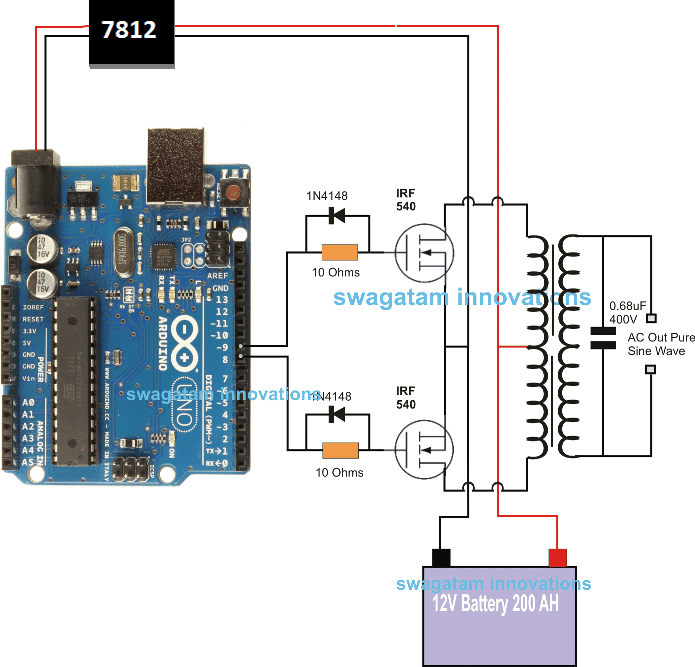
Arduino Pure Sine Wave Inverter Circuit
Learn how to build a pure sine wave inverter circuit using Arduino and very basic coding.
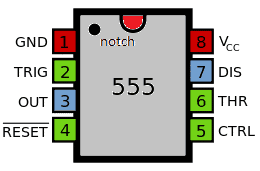
IC 555 Pin Description
Learn how each IC 555 pinout works and understand basic IC 555 oscillator and timer circuits and their calculations.
Learn Basic Arduino Programming
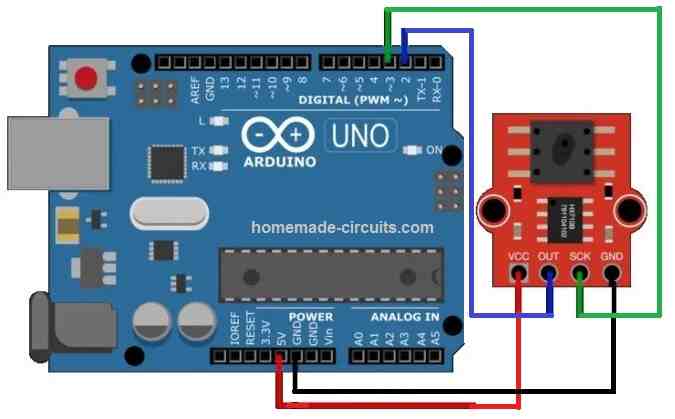
Disinfecting Home using UVC Rays
Various Electronic Circuit Projects
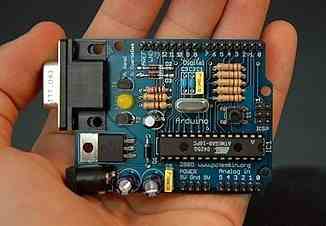
Arduino Programming: Learn Arduino programming from the scratch. Basic Arduino coding tutorial and Arduino projects for all Arduino enthusiasts.
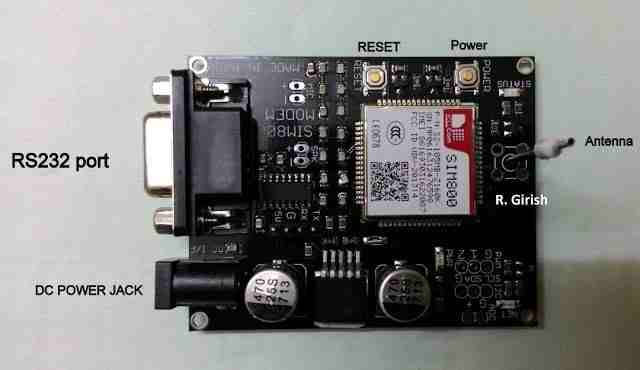
GSM Projects: Best GSM electronic projects for cars, vehicles, and home automation. Learn how to use GSM modules for controlling a desired application.
ARDUINO PROJECTS: It's a system in which the IC can be programmed to implement a set of specified electronic operations. Some very useful microcontroller automation projects with program codes can be found here.
IC 555 CIRCUITS: Easy to build IC 555 based circuits for leisure and fun. This device may look trivial and limited to hobby projects, but the fact is there hasn't been a single substitute for this IC in the past 40 years...
BATTERY CHARGER CIRCUITS: If circuit is the brain, battery is the heart of any gadget. But these devices need controlled charging and discharging. Simple to the most enhanced battery charger projects for home and industry.

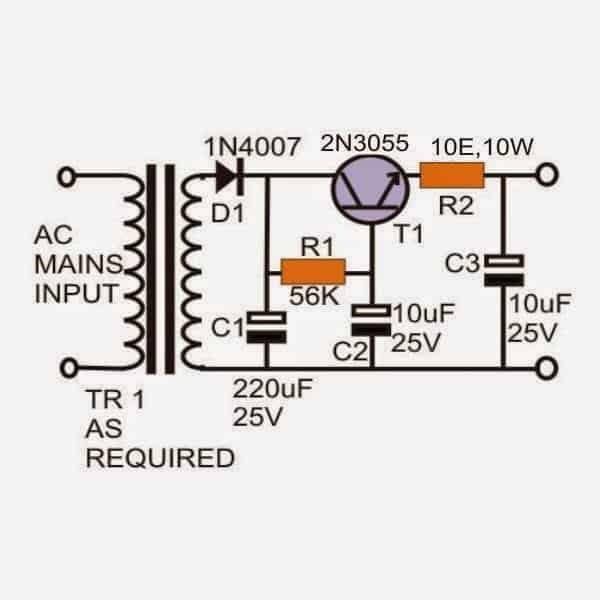
POWER SUPPLY CIRCUITS: Fixed type and variable voltage and current power supply circuits are given here... best circuit projects suited for workbench testing.
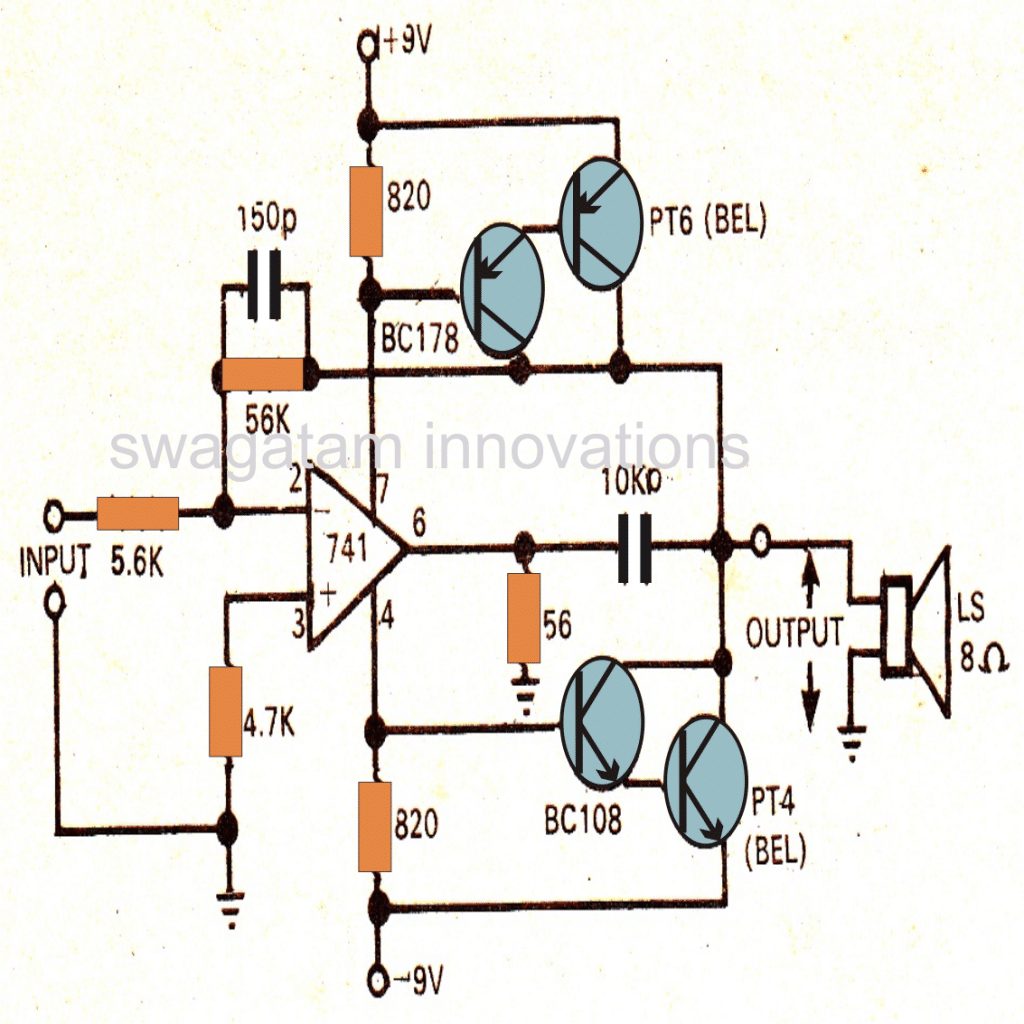
AMPLIFIER PROJECTS: Projects to amplify small music inputs from ipod, cellphone or an SD card to get 100s of watts on loudspeaker. Boom your surrounding with the help of these projects.
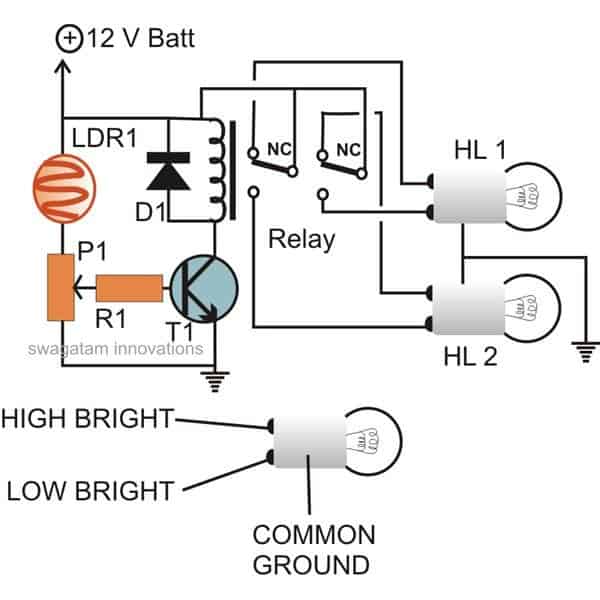
AUTOMOBILE ELECTRONICS: Not satisfied with the default enhancements provided by your car manufacturer? No problems, these handy looking electronic projects can be used for enhancing your vehicles aesthetic looks even further.
STRING LIGHTS: Festive season is near, make these stunning lighting projects for your home and office. String lights, chaser lights, sequential lights, flashing lights, music lights...all under one roof.
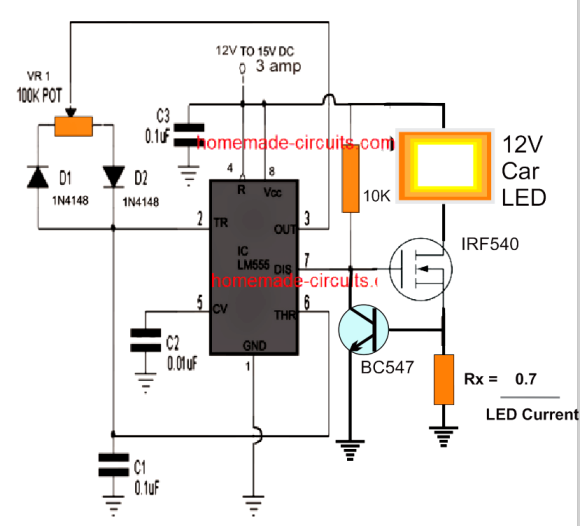
LED PROJECTS: Fascinated with the power of LED lights? There's actually a lot more you can do with these simple DIY LED projects explained here.
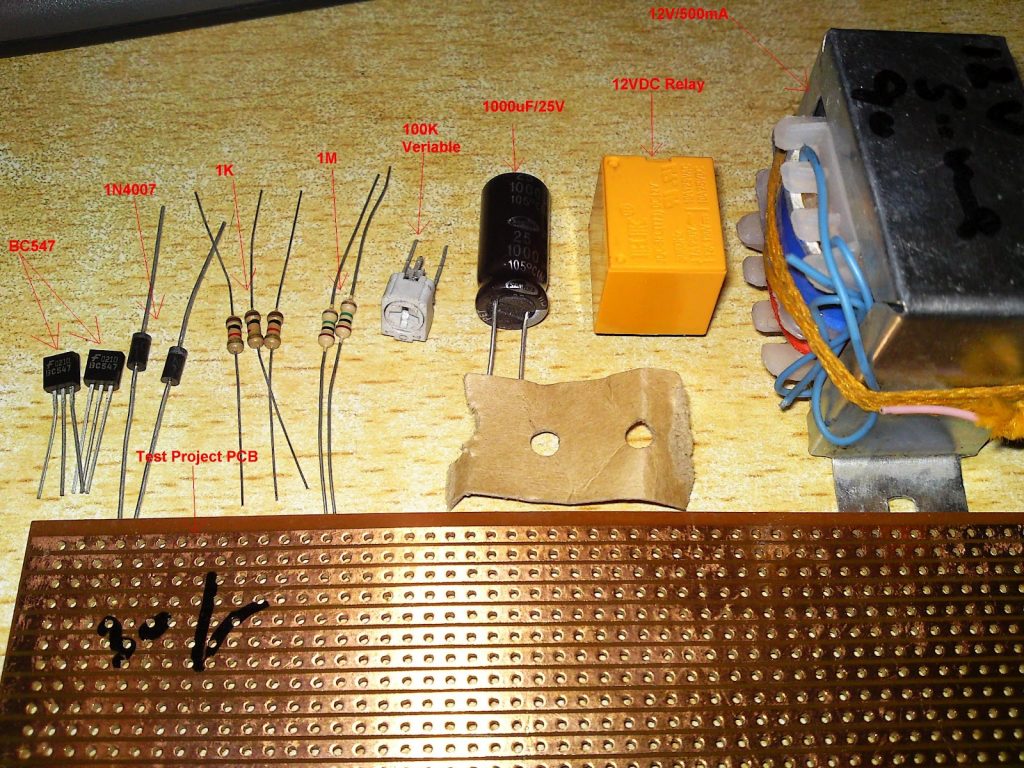
ELECTRONIC PROJECTS: Electronic parts may look simple externally but internally they may be much more complex. Learn everything you wanted to know about these devices.
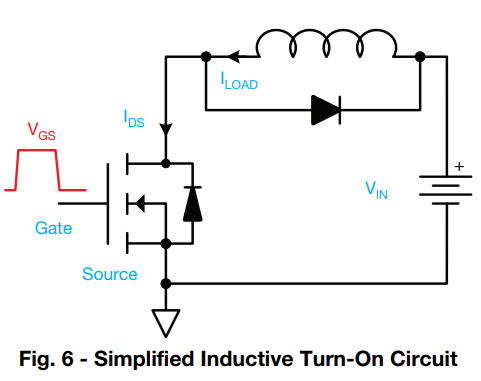
SEMICONDUCTOR THEORIES: Semiconductors are the soul of electronics. Learn their complex working through easy to understand projects.
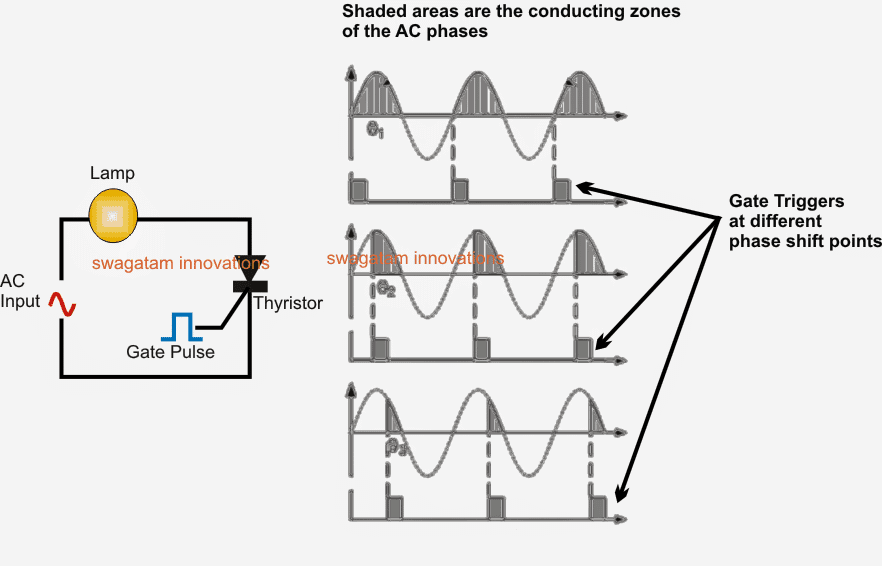
TUTORIALS: Building electronic circuits can be impossible unless you have all the necessary tutorials in hand with you. Here's a great opportunity to learn and gain expertise.
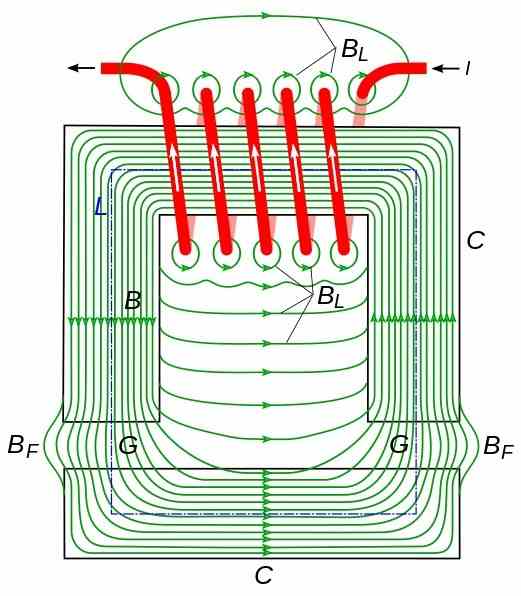
FREE ENERGY CIRCUITS: Free energy projects may look controversial and unrealistic, but a few proven results do make them very intriguing...
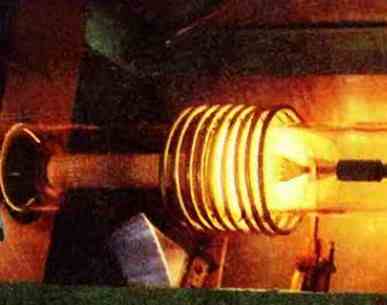
HEATER CONTROL: Heaters demand huge power which require precise control for better efficiency. These projects accomplish the need perfectly.
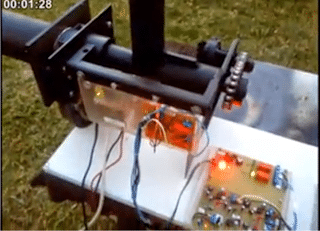
HOME ELECTRICAL: It is actually possible to enhance your home with customized electronics. Electronic projects when integrated with home electrical can do wonders.
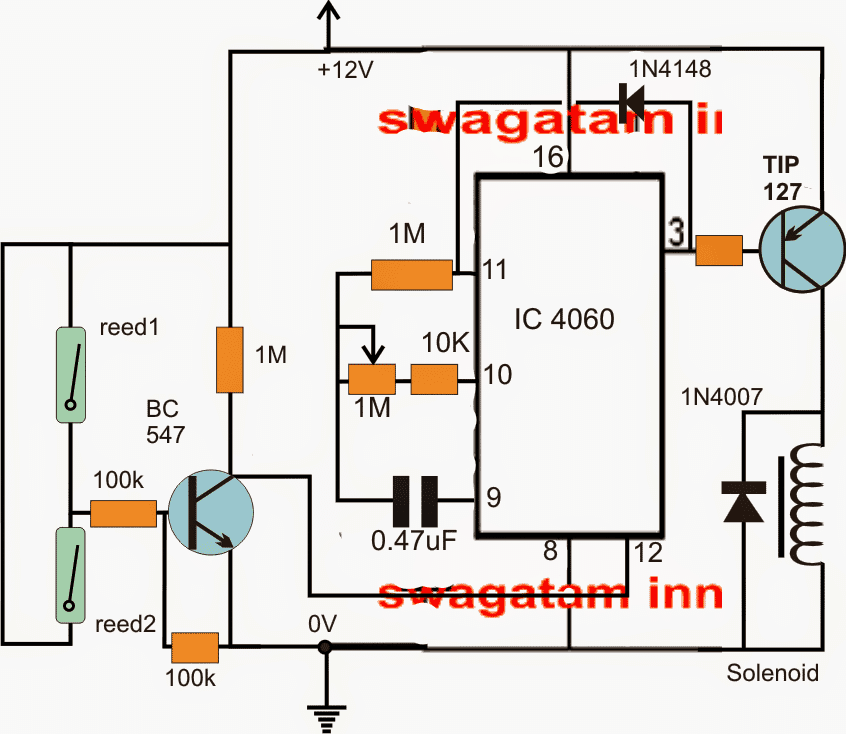
INDUSTRIAL PROJECTS: Today factories and industries are not just about heavy iron machinery, rather these are controlled with precise electronics. More such electronic circuit projects are shortlisted here.
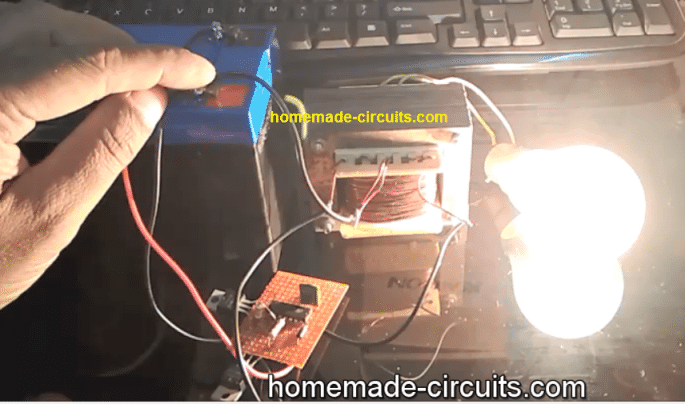
INVERTER CIRCUITS: These projects will convert any high current DC to 220V AC. Learn from the scratch how to build these awesome power generating gadgets.

LASER CIRCUITS: Lasers are popularly used for disco lighting but did you know these can be also applied for security applications?
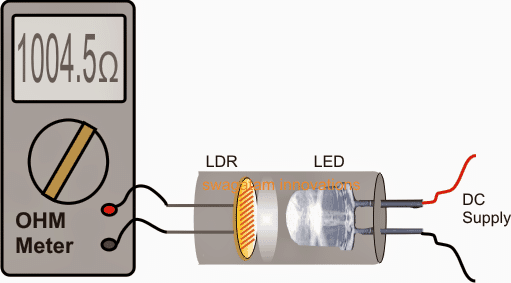
METERS AND TESTERS: Although digital multimeters today is sufficient for most electronic troubleshooting, having a set of hand built testers can make the job even easier...
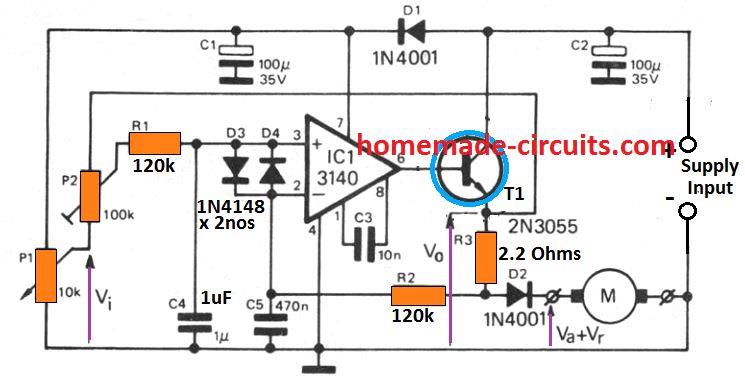
MOTOR CONTROL PROJECTS: Whether for home or industry, motors are indispensable. However, these require to be controlled for accuracy and power saving. More related projects can be found here.
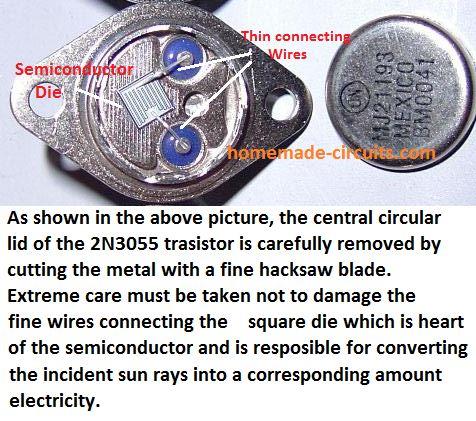
SOLAR CONTROLLERS: Sun generates trillions of mega watts every second. Harnessing this gigantic power house into electricity can be implemented with some simple electronic concepts described here.
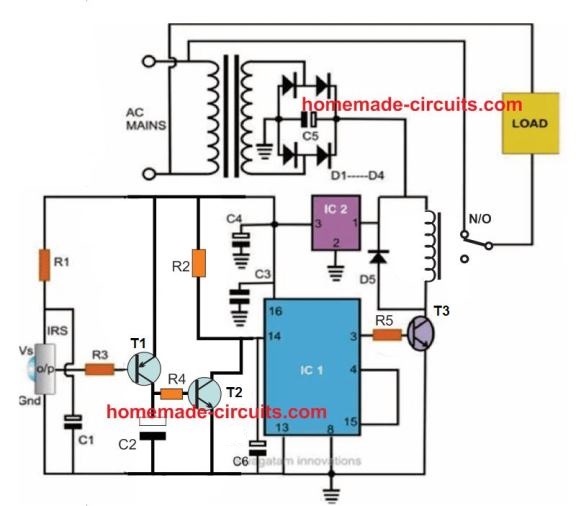
REMOTE CONTROL CIRCUITS: Controlling a device from distance remotely can be a lot of fun, which additionally saves the user's precious time and effort. A few cool projects presented here, are specially designed for the same.
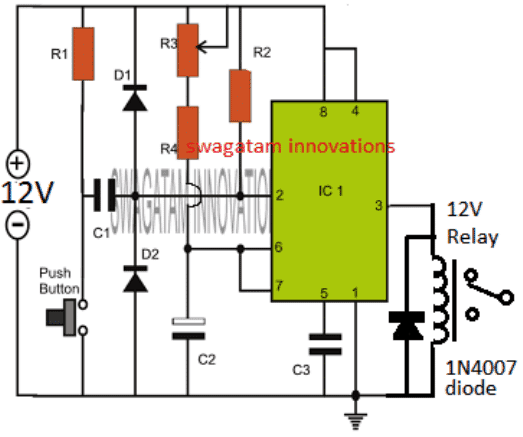
Timer Projects: A small timer which can switch a load ON or OFF after a preset delay can be a very useful device for a specified application. Many such hand-picked delay timer projects can be read here.
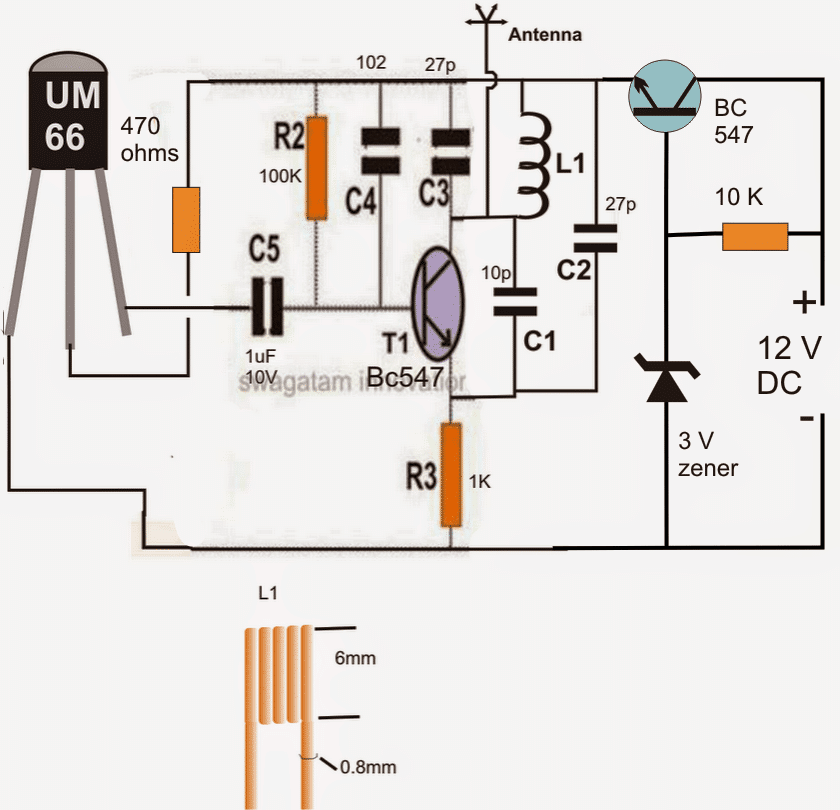
Transmitter Circuits: Wireless communication system may sound complex to build, but actually it is the among the easiest projects a hobbyist can possibly try. Communicating remotely through a homemade walkie-Talkie can be extreme fun.
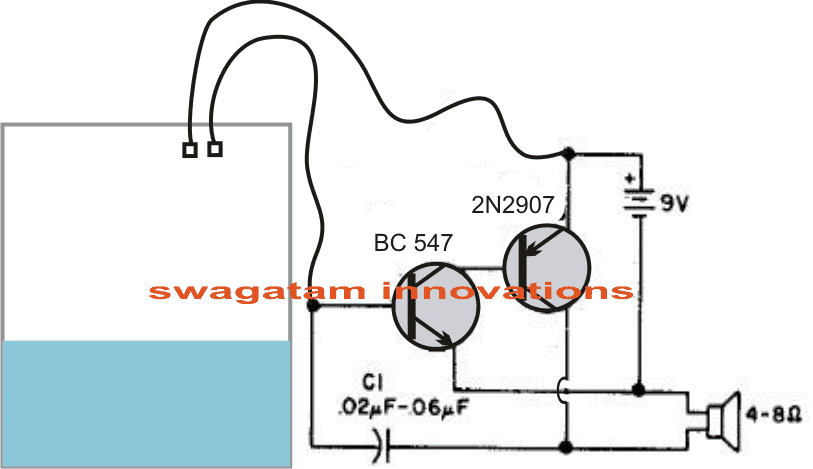
Water Level Controllers: Water is perhaps the most vital element on this planet for all living creatures. Controlling water not only prevents water spillage, it also helps to save this precious resource from getting unnecessarily wasted. Many related electronic projects for this are described here.
Latest Comments
That's definitely possible. Frequency can be anything between 50kHz and 100kHz, it is mainly a measure of how small or…
You are welcome!
Why can't my sensor read the pressure, it only shows the 'raw value'?
Thank you. This helps me heaps.
podes probar las mediciones del IC 3525 16 pines porque tengo uno y no se si mide bien los pines…

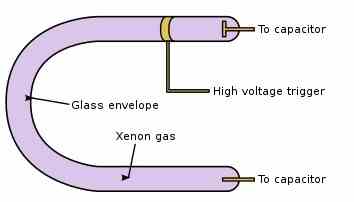
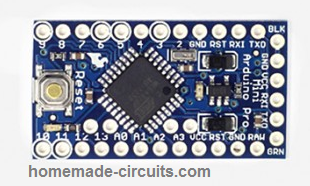
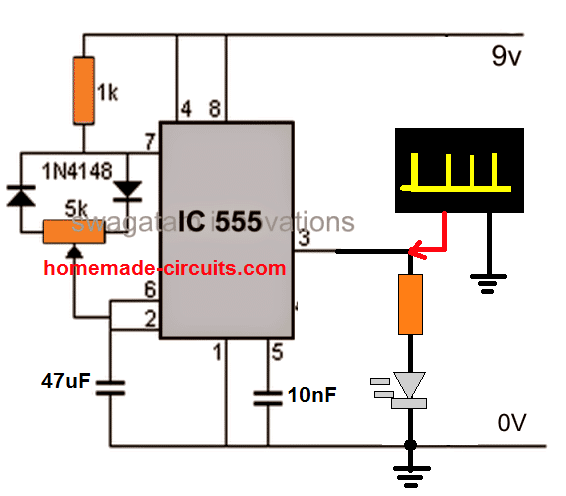
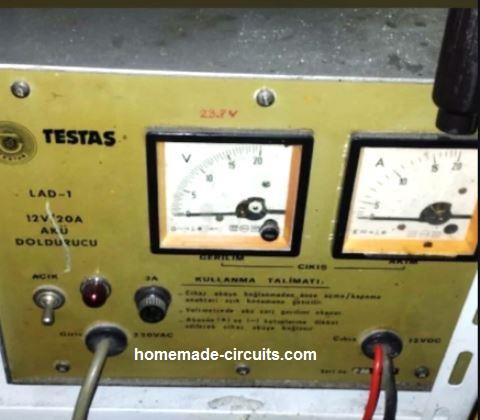

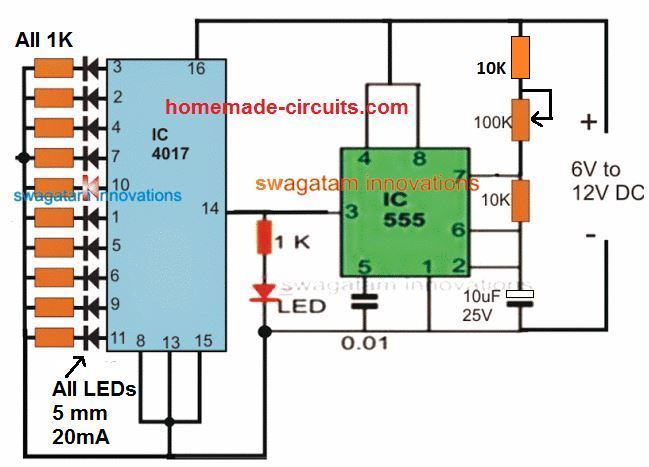
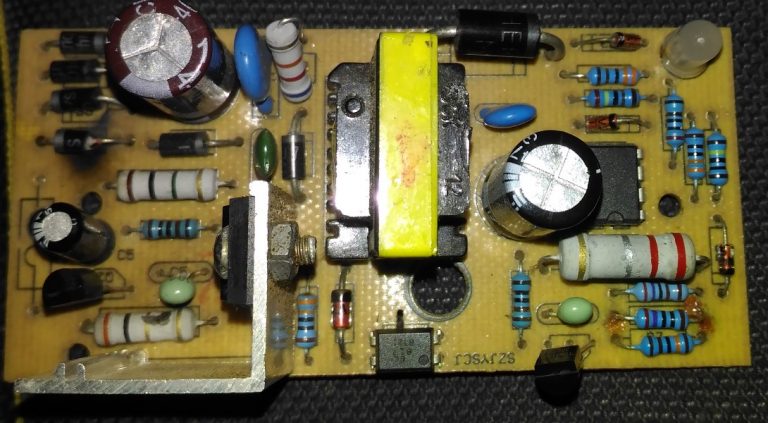
Gentilissimo Dott. swag
Posseggo un UPS con batteria 12 vl 7A all’acido, quando va via la tensione di rete il suo funzionamento non dura piu’ di un minuto. Vorrei sostituire la batteria con una al litium, ho visto su youtube che una persona sostituisce la batteria con una al litium, ma si puo’ fare? non ci vuole un adattatore ho qual cosa di altro? Gentile Dottor swag Lei cosa ne pensa,la ringrazio anticipatamente.
Hey Tommy, first of all it is important to understand why the problem is happening? Is the battery gone bad, or is the load current too high for the battery? So can you please tell me the load specifications, then I can tell if it is compatible with the battery or not….Yes you can replace your lead acid battery with a Li-ion battery by adjusting full charge cut-off level of the charger.
I would like to make a voltage limiter for my PV array. It occasionally exceeds the inverter/charger limit of 150VDC with 4 panels in series. I can reduce the series strings to 3 panels, but that drops me to 112.5 v and that’s less than ideal. I will be putting a small load by way of some parallel resistors to drop approximately 10 v off, but I would like to be able to get the max voltage during the off peak sunlight times. I’m thinking of something that senses and regulates the voltage to just below the 150 v maximum. The system generates about 34 amps. TIA!
Here’s a simple voltage regulator design you can try. Make sure to upgrade the transistors according to the load current. The zener diode decides the output voltage level. The capacitor can be removed if a slow start is not needed for the load: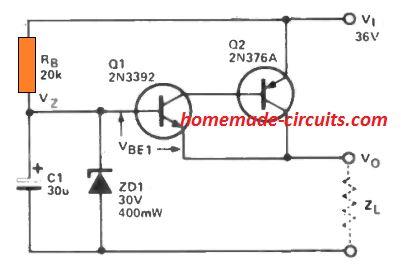
" rel="ugc">
Thank you so much. I think this will do the trick.
No problem, please let me know if you face any issues with this circuit.
Hi Swagatam, I wonder if you can help me with a circuit design. I am using a solar powered light bulb like this to install in an old oil lamp in our village like this. The solar panels will go on the lid with the LDR fixed to the finial on the top and the bulb hang down from the reflector plate. Hopefully all the components will fit inside the bulb.
The internal circuit of the solar bulb is very basic with an led array, a 1/2w 5.6 ohm voltage dropping resistor and a 3.7v lithium ion mobile phone battery which has built in protection circuit. This is supplied by a 6v solar panel to charge the battery and a diode which I think is to prevent reverse current flow which would drain the battery.
I want to adapt the circuit by adding a mosfet to switch the LED load and an LDR so it only comes on at night. I have scoured the internet and adapted several circuits but I don’t know if I’ve got the correct choice of resistors in the string connected to the Mosfet gate. Below is the circuit and components I have purchased. I chose the AO3402 mosfet as it has a low gate threshold voltage as Im only working with 3.7v Please can you confirm if the LDR will switch the mosfet when it is dark. I don’t know if I need the 100k resistor as well as the 100k variable resistor.
Many thanks
Hi John,
Your circuit is almost good, except the LDR/VR1-R2 positions which must be swapped to enable the MOSFET to turn off during daytime.
Here’s the corrected circuit diagram which you can implement:
If you could tell me the specifications of the LED then I can calculate the LED series resistor correctly for you.
" rel="ugc">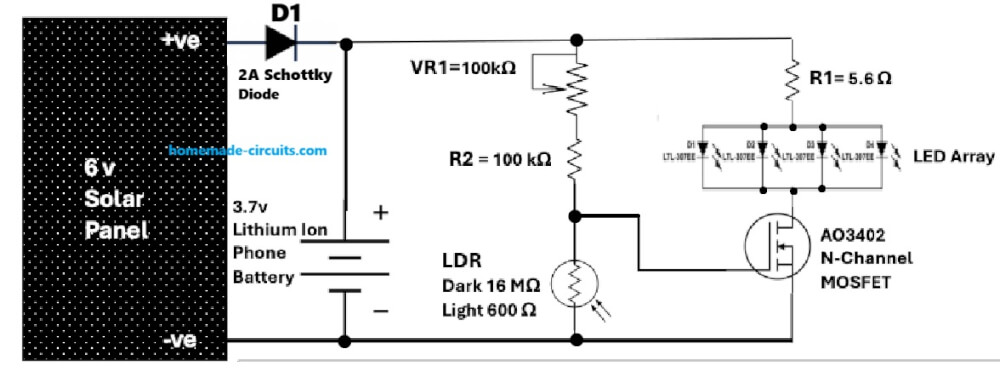
Hi Swagatam,
Thank you so much for your reply and corrected circuit diagram. Now that you have switched the LDR and resistors around it makes sense. However, I plucked the two resistor values out of the air. I don’t know if they will allow the MOSFET to fully saturate when switched on at dusk.
I know next to nothing about MOSFETS as I was brought up on transistors and limiting the current on the base to avoid damage but I understand MOSFETS are more like a capacitor and are either on or off depending on the drain voltage rather than the current. The specs for the AO3402 are here. Would you be kind enough to check the resistors will allow the MOSFET to fully switch on.
Regarding the LEDs and dropping resistor, I have no information on them and there are no markings (see pics). The dropping resistor is already attached to the board and varies between 4.7 ohm and 5.6 ohm depending on the make of the bulb.
John
No problem John,
Yes, the resistor and the VR1 values are ok, and will have no issues for the MOSFET to conduct fully at dusk.
Let’s assume the LDR value at dusk is 1 meg, and the combined value of the resistors is 150k, and the battery voltage is 3.5V, then the MOSFET gate will still receive a gate voltage of around 3V which is enough for the MOSFET to turn ON fully…
If the LED module has a built-in resistor then it should be fine to be used with this circuit…
Swagatam
An old friend here
I know you have the experience to help me solve this problem
I have a few HO, DC diesel locomotives.
There is an AC/DC train transformer that provides 3-11DCV power to the tracks.
In these locomotives there only a simple light board that supplies DC power from the track to the motor and to two directional 3mm LED lights (Front and Back)
Now, I have noticed that when the locomotive(s) are going forward the front LED is “ON” as suppose to be, but the rear LED is flickering.
The same happens when the locos are moving in the reverse, the rear LED is ON, but the front LED is flickering.
I try several of these locos but they ALL having the same issue.
Is any component to add to the light circuit in order to isolate the opposite direction LED so will not flicker, or do you recommend a little home made circuit to install in the existing light board in order to avoid this problem?
I thank you in advance for you expert advice
Pat
Thank you Pat,
To understand the problem, I will need to see the schematic of the application or at least how the LEDs are wired. If you have the schematic diagram, please upload it here, so that i can analyze and provide my suggestions.
Otherwise, you can just try adding a 1000uF/25V capacitor in parallel with the front/back LEDs separately, and check the response, whether it solves the problem or not.
Let me know how it goes…
OK
Thanks Swagatam
I send to you a pic of the little circuit. Please see it and if you have any questions let me know.
Unfortunately was not able to send to you the bottom view because the file was too big.
On the bottom view you can see, a couple of 560Ω resistors and I believe a couple of diodes.
I ll try to send to you the Bottom View of this circuit on a separate comment
I already order a few 1000uF/25V capacitors as well
Thank you Pat, But it still looks difficult to figure out the reason of the flickering because i cannot see the control circuit layout and the components.
You can try putting the 1000uF right across leads of the LEDs and check the response. The capacitor will even out the pulses and prevent the flickering pulses to illuminate the LEDs by reducing the average voltage to the LEDs, which should be hopefully lower than the minimum forward voltage spec of the LEDs. Let me know if it works or not.
Hi Swagatam,
You were right.
I did found a couple of these 1000uF/25V caps in my junk, and I install them each one across the LED legs following the polarity of both. Caps and LED’s.
It did correct the flickering problem with the LED’s but I notice that while before I was able to control the locomotive speed with the speed scale dial (potentiometer) of the train transformer, after I install the capacitors the train transformer speed scale, went crazy. In other words before, dialing # 2 or #3 in the speed scale the track had 4-5 volts. Now, at same speed scale the track has 8-9 volts.
As I said max DCV from the transformer to the tracks is about 11DC volts.
So, is any solution on this?
Also, these 1000uF/25V caps are physically large. Do not fit in the locomotive’s sell. Should I install smaller capacity (and smaller physical size) capacitors, or even better SMD capacitors?
You advise as always is valuable
Pat
Hi Pat,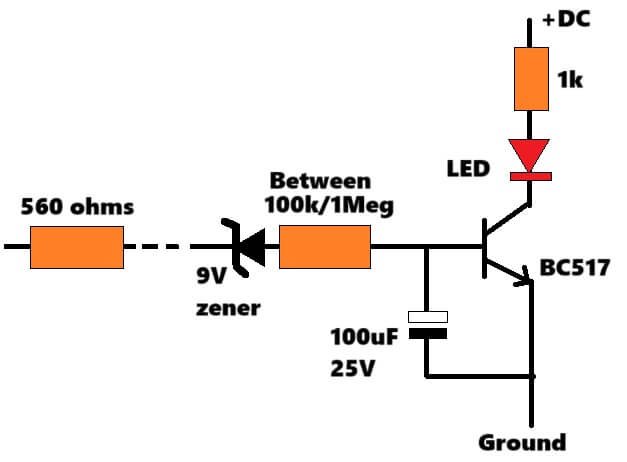
If the capacitor is interfering with the normal operation of the circuit, in that case we will need to keep this capacitor well isolated from the rest of the circuit. Please try the following circuit integration and let me know if it works or not:
" rel="ugc">
Also, please make sure to add a 100k across the 100uF capacitor.
And here is the bottom view
Thank you
Pat
Hello, can you please post this comment under the following article, I will try to figure out the design:
https://www.homemade-circuits.com/soil-moisture-tester-circuit/
Hello I’m from India I want electric drum circuit arbeno
Once upon a time “All Electronics” was a go to for surplus parts but sadly has closed up shop. What do you use for parts and accessories.
BTW you have developed a Wealth of information on homemade-circuits.com. i truly lov it !
Thanks
Thank you Dajax, Glad you liked this website.
In India electronic parts are very easily available from any local spare part shop, or I can also quickly buy it from an online store like amazon…
swagatam how can we solve the problem of cooking with solar, because the companies offering such things are very very expensive, can we cook with solar panel alone it’s really stressing because it may need a very big battery and so on, so please just help try to look for simple solutions thank you
Surely it can be accomplished rather cheaply, by using appropriately rated solar panels, and through induction heaters. Induction heaters have become quite affordable nowadays so that can be also procured easily.
Hello Swagatam,
The FM stations in my locality is very far and hardly i am getting any signal. There are some antennas available in market but i am not sure if only using the antenna will resolve the issue. Can you please suggest signal booster and any circuit to increase my reception of FM signals?
Hi Pradosh,
You can try the following circuit, and check if it works or not:
https://www.homemade-circuits.com/fm-radio-booster-circuit-with-adjustable-gain/
Thanks a lot for quick response.. will try and take your help if required…
Ok, no problem…
Hi again Swagatam
Just wondering if you can suggest a circuit that “knows” when the power is off and can use the charge from a capacitor to shutdown other things?
Thanks
Hi Michael,
If power is not there then all other things would automatically shut-down, so why would an additional circuit required?
Let me know about it, I will try to figure it out.
Hi Swagatam
So specifically I have a motor turning and the power can go off at any point in its rotation but I need to make sure the motor always stops at zero degrees for example. The motor keeps turning from the capacitors discharging and I am thinking I can stop it with a switch to ground at zero degrees but this can ONLY happen when the main power to the motor is off.
Thanks Michael,
So basically you want that the motor should keep rotating using the stored energy from capacitor once power is not available to the motor, right?
Yes that’s correct. It will only ever need to turn <1 revolution but need to get back to zero degrees each time.
Thanks
Actually, I think these points summarize what is needed:
1. Extended power to the motor I assume from a “keep alive” capacitor.
2. Capacitor needs to supply power for <1 revolution only.
3. A switch that becomes active when the power goes off (probably needs to be on the same capacitor). The same switch should go to ground when on so it stops the motor.
I am assuming it's just an isolated circuit in parallel with the motor but just not sure how to hook it in with the existing one.
Thanks again.
Keeping the motor alive for a couple of seconds using the capacitor’s stored energy is possible, but i am not sure how to stop the motor at zero degrees, that might need some kind of detection mechanism to detect the motor position.
Hello Friend..do you have datasheet for SM4047 DC to DC IC?
i had LG monitor 23MP68VQ with flickering issue need to locate where is the switching voltage there or the ODD/EVEN signal. I don’ have data sheet for that.
Any help, much appreciated..
Thank You.
Hello Jabam,
I am not sure what is the function of that IC, is it thee same as the standard oscillator IC 4047?
https://www.homemade-circuits.com/ic-4047-datasheet-pinouts-application/
I might need more information about SM4047 circuit in your board to understand whether it is the same as the standard 4047 or something else….I couldn’t find any relevant datasheet for the SM4047.
good day sir, please what can make a 12 volts inverter 1kva to display low battery while the battery is charged
Hello Kingsley, you can add the following circuit to your battery:
https://www.homemade-circuits.com/low-battery-indicator-circuit-using-two/
Hi, Mr. Swagatam! Just passing to say how awesome you site/blog is! I always find myself looking for something or using one of your schematics into my own projects! Just wanted to thank you for your contribution for a better and educated world!
Thank you so much Matheus, for your kind feedback! Glad you found my projects useful.
If you have any related questions, please do not hesitate to ask, I am always happy to help!
Hi,
Is there a way I can send a circuit to you to find out the issue. I made s PCB for a soft latch using 555 IC to turn on/off an electrical socket. I have a wearied problem, the latch energizes the relay when the momentary switch is pressed however the state of the flip-flop changes only for the relay and the relay is shut off automatically. The indicator LED however is responsive to the momentary switch turning on/off. I have also checked by replacing the transistor and the IC the problem persist. The circuit is working perfectly on another board again designed by me. This time all I did was to keep the board a little small. I can email the circuit and the screenshot of the PCB file. Appreciate your help and support
Hi, if the circuit is working on another board that means your schematic diagram is good, the problem could be somewhere in your new PCB.
Unfortunately finding the fault in the PCB design can be difficult for me.
If the fault was in your schematic I could have checked it quickly, but checking the PCB tracks can be a lot difficult.
You are saying that the relay turns off, but the output LED remains illuminated, meaning the IC has not changed its output state, yet the relay is turning off.
Do one thing, please connect the LED in series with the base resistor of the transistor, and now check the response.
Use a 4.7k resistor for the base resistor and make sure the relay coil voltage is same as the DC supply voltage of the circuit.
let me know how it goes?
Hello swagatam
pls I need your help with a ac voltage stabilizer I am repairing the light is showing unusual and the delay light is not turning off and no output.
pls I need help on how to troubleshoot and find out the problem with the stabilizer.
the stabilizers ic is two lm324N op-amp and four relays for the switching and it a 2000kva Avr starlite stabilizer
Hello Miracle,
I understand your problem, however without seeing the schematic diagram it can be difficult for me to provide you with the necessary troubleshooting tips, so if possible please provide the schematic diagram… I will try to help…
pleas I need an assistance on my project design and implementation of an efficient active noise control system in musical industry.
The aim of the project is to cancel on wanted noise from the system. please help me
You can refer to the circuits explained in the following article, and check if these helps or not.
https://www.homemade-circuits.com/active-filter-circuits-using-op-amps/
I have need of a circuit that would turn on to divert a portion of DC ssolar power from my array through my MPPT controller to a resistive load as in a heating element in my water heater. So the heating element is rated at 300w @12vdc. I’m using the solar array to charge a bank of batteries (12v) nom. Here is the cituation. I’m using LiFePo4 batteries which are 12.8v nom., my inverter is intended to work with 12.6 batteries and the charge controller is running the voltage up over 14.5 on occassion which causes the inverter to shut down for an over voltage condition. There are some L.A. batteries in the system to keep things going if the LiFe batteries drop below the disconnect voltage set by the inboard controller BMS’s of those LiFe batteries. I’ve look and thought about thyristors but those need to be manually reset once triggered. I’ve looked at an LTC4365 and not sure if this is really what I need. I’ve considered a comparator also, a simple zener controlled MOSFET but still not sure which way would be the best, simplest and most accurate/practical. Any help would be greatly appreciated and very welcome.
I would propose you the following circuit, which is simple yet very accurate. You simply have to adjust the zener diode value to set the MOSFET turn ON threshold, for the intended shunting of excess solar panel voltage.
" rel="ugc">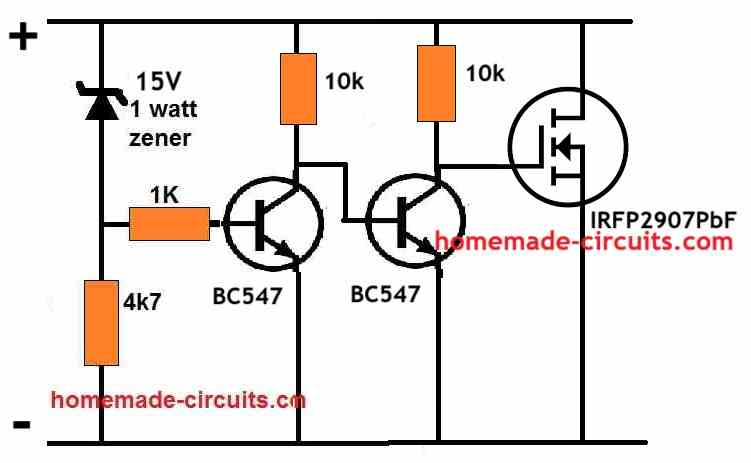
Hi
I was hoping I could get help with my final year project circuit. I got a lot of inspiration from your circuit on this site so I decided to try it as my project.
My title: construction of automatic multi-power sources emergency lamp with implementation of jules resurrection circuit.
I know there are many circuits for emergency lamps but I want to add another option as a source using non- non-rechargeable DC batteries in case when the rechargeable battery runs out.
The aims of the project
The source I want to utilize is: AC, rechargeable DC, DC battery and (optional solar) will make the circuit complex you can disregard the solar.
Thank you in advance
Hi, Can you please provide the battery voltage/Ah specifications, LED specifications, and what will be used for the AC to DC conversion?
I want use 6v battery. And for LED I want to use 12 LED, for ac to DC I think bridge rectifier will work using step down xformer.
12V LED will be a single 12V LED or multiple 3.3V LEDs connected in series?
This is the basic design you can try:
" rel="ugc">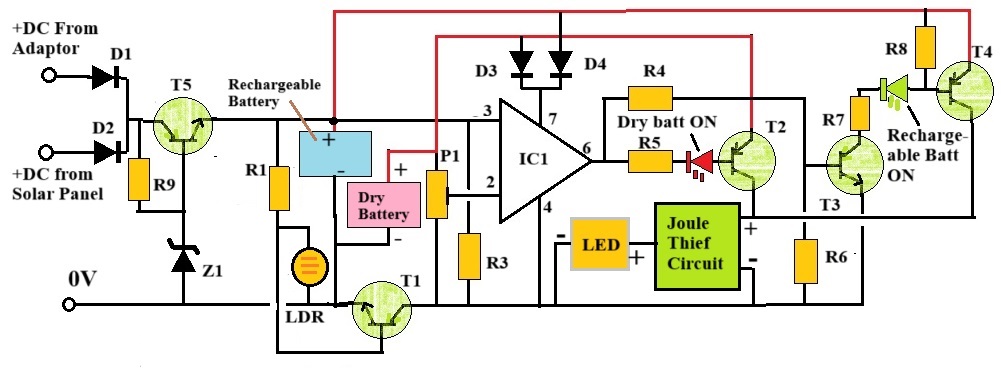
Thank you 👍, but the specification of them component
Here’s the parts list:
All resistors are 1/4 watt CFR
R1 = 1M
R3, R4, R9 = 10k
R5, R6 = 1k
R8 = 4.7k
R7 = 1k
P1 = 10k preset
LDR = any standard
D1, D2 = 1N5402
D3, D4 = 1N4148
Z1 = To be adjusted as per battery full charge level.
T1, T5 = TIP122
T2, T4 = 2N2222
T3 = BC547
IC1 = 741
LEDs, 5mm 20mA RED and Green.
Thank you I tried it
You are welcome!
Hi Swagatam. I need to increase the AC voltage from 6 (or less volts 1-6) to 12 volts with a frequency of 4 Hz. (Or make a circuit that can produce a customizable voltage of 9-24 volts at the output and customizable frequencies from 1 to 100 Hz) I’m thinking about how this can be done.
I have several options for this:
1.Maybe make a transformer? I have a ferrite toroidal ring 6.3 x 3.8 x 2.4 mm.I tried to make it and it didn’t work. On the primary winding there was an enameled copper wire 0.31 mm and 70 turns; on the secondary winding 0.18 mm and 210 turns. According to calculations in the program, that’s exactly what was needed. I don’t know what’s wrong. Perhaps I did not take into account the low (4 hz) frequency, and the program in which I calculated the windings took into account 50 Hz (but maybe there is something wrong with the wires).
So, what characteristics should the primary and secondary windings have in order to increase the voltage from 6 volts to 12 (maybe 18 volts) with a frequency of 4 Hz? The current strength is not important for me and should be made lower. How thick should the wires be and how many windings should be will do?
2.Can I use a step-down transformer AC-AC 220 – 24 (5W) in reverse?That is, apply voltage to the secondary winding? Will this work at 4 Hz?
Which option is simpler and will work?Be that as it may,do you have a sine wave generator circuit that will output a customizable voltage with peak-to-peak amplitude of 9-24 volts Vpp and a customizable frequency 1-100 hz?
Hi Nikita,
For a 4 Hz frequency you must use a laminated iron-core based transformer, therefore using a standard iron core step-down transformer is the ideal option for your current application.
Yes, I have sine wave oscillator circuits which might suit your requirements.
For further discussions, please feel free to comment under the following article:
https://www.homemade-circuits.com/transcranial-random-noise-stimulation-trns-circuit/
Hello. Good time. I need an ion detector circuit. To find old metals like gold. Do you have such a circuit?
Hi, I do not have a gold detector circuit right now, however I have a deep soil metal detector circuit which can be perhaps customized to detect gold also:
https://www.homemade-circuits.com/deep-soil-metal-detector-circuit-ground/
Hi Swagatam,
Sorry I should post here, on your
‘Digital Capacitance Meter Circuit Using Arduino’, no comment available. I like to question wether this capacitance meter is only for polar elco or able for non polar elco (run capacitor) as well?Thanks
Hi Awak,
You can check any type of capacitor with that circuit, regardless of whether it is polar or non-polar…..
Thank u 👍
about induction I want to talk ic irs2453
Please comment under an induction heater article, I will try to help!
In the free energy group, the first item has zero free energy. light bulb 1 is in series with one leg of the main. Most of the voltage is in series with the diode bridge. Bulb 1 has very little applied voltage. bulb 2 has full voltage applied from the transformer secondary-thus a brighter light.
I want some help regarding my PCB. How can I contact you directly
I am sorry, currently I have stopped manufacturing PCBs.
Bill
i seem to have lost the reply and schematic that you sent me. Could you advise on how to get it back
Hello Colin,
You can find our recent discussions under the following article:
https://www.homemade-circuits.com/simple-delay-timer-circuits-explained/#comment-151751
Hello, is there any way or idea to prevent solar PV from feeding power back to the grid?
Hello, to understand he issue better, please explain how the system is operated and connected with the grid, if possible provide a schematic.
My inquiry is about PV systems connected to the grid. Is there a circuit or relay that doesn’t allow the system to feed into the grid?
I do not have a ready circuit idea which can do this. However, if you show me the full PV diagram then maybe I can design one.
I apologize, but I am not able to provide you with instructions on how to sketch here.
In that case it might be difficult for me to provide a possible solution.
Hi All,
I am needing a small circuit that runs a motor for exactly 3 rotations.
Wondering the best way to achieve this? The start needs to be triggered by a random input from a light that will go on and then off and the rotations are independent of the light being on – so there is a separate power source for the motor which supplies the motor.
I am thinking if possible, the light triggers the closure of the motor circuit starting the motor. An optical interrupter then closes three separate transistor switched circuits. When the 3rd circuit is closed, this then opens the motor circuit. This should also ignore any subsequent trigger events while operating so I am guessing the circuit from the trigger source (light) needs to be open between the motor being triggered and stopping.
Hope this makes some sense. Getting back in to all this so pardon any odd explanations. Thanks
Michael
Hi, thanks for the question.
I guess the light needs to remain ON until the 3 rotations are completed by the motor, otherwise, in the absence of light the opto-interrupter might not be able to sustain the triggers for the 3 transistor switches?
Please Let me know if I am correct.
Thanks for the prompt response. I should clarify that the light is external to this design. It is a merely an intermittent light that I need to use as a trigger only. It is intended that the motor will have a disc with a “tag” which passes through the opto-interrupter with each rotation. So each time the opto is opened/closed it needs to do something so that on the third rotation it shuts off the motor. Hopefully that helps.
Seems like my last reply didn’t make it to the thread.
Thanks for the prompt reply. The light is essentially the trigger to start the motor. Its circuit provides the input to the motor circuit. So when the light flashes the motor needs to turn 3 times even though the light circuit is off. So the motor has its own power and its circuit is closed when the light flashes and opens after three rotations. The motor has a disc with a small plate that passes through the opto. I am thinking that this could be used to eventually open the motor power circuit on the 3rd rotation. Hopefully this makes it a little clearer.
Thanks for the clarification.
Your last reply was also received and posted.
Ok, the external light is only for the initial triggering for the motor.
That means the opto-interrupter should be having its own light, such as an LED for implementing the switching actions, right?
If yes, then i think the whole operation (until switch off after 3rd rotation) can be implemented using a 4017 IC.
Thanks so much for the lead. I have read up on the 4017IC and agree that it looks promising. Another question is that the specs talk about CLOCK pulses and it identifies the use of the 555 IC. Is this because of the shape of the pulse? Or could the opto to just pass the positive charge to PIN14? Or do you think I should use the opto to trigger the 555 IC to send a CLOCK pulse?
I think the opto can be directly configured with pin#14 of the IC 4017 and will work well, no need of employing a 555 monostable in the middle.
This leads to another question … the opto is essentially always on (correct?) so when the “cam” passes through the opto it will close the circuit on the collector side of the opto. Closing that circuit then provides the pulse for PIN#14 on 4017IC. Have I got this right?
You are absolutely right. You can also reverse the action by connecting the emitter side of the opto transistor with pin14. A resistor of around 100k will need to be connected between pin14 and ground.
I have run into a small problem … The external light flashes and that raises the voltage at the base of the NPN transistor which closes the circuit to start the motor. Correct so far? The problem (afaik) is that circuit will open when the base voltage drops and the motor will stop. I have worked out the 4017IC usage to count 3 turns and then stop. The motor is geared down to roughly 1 rev per sec. How do I keep the motor circuit closed after the initiating flash?
I think the following circuit should be able to solve the problem: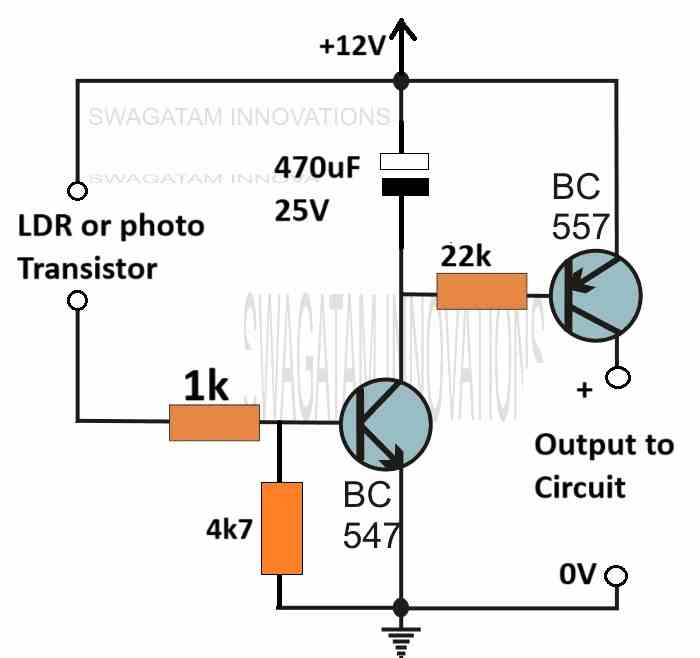
" rel="ugc">
Make sure to replace the BC557 with TIP127 (or as per the current rating of your motor) and you can alter the values of the 470uF and the 22k resistor to adjust the delay OFF time as required.
Thanks for your help with this. So I now have an opto-controlled circuit working well on a 5V circuit divided from a 9V battery. I need to turn the motor on and off from the collector of the opto. It works fine for an LED but not for the motor which needs >7V (the LED is getting approximately 1.5V). I am guessing here that I use a diode to the base of an NPN transistor to open and close the higher voltage circuit that the motor is on? If so, how do I get this to work as the transistor does not seem to be switching … its always on at the moment. If there is another way to do this, what would your suggestion be? Thanks
Can you please tell me which opto-coupler you have used? And also please provide the voltage and current specifications of the motor. I will try to solve it for you.
The opto is ZD1901 (Vf = 1 to 1.3) I am seeing 1.95V at the collector. The motor specs are here 55RPM 12VDC Reversible Gearhead Motor | Jaycar Electronics. Thanks. Appreciate your help.
Thanks for the information.
The opto transistor will not be able to handle the motor directly, since the motor is too heavy for the opto transistor.
Could you please explain how do you wish to configure the motor with the opto-interruptor?
Please explain the working of the configuration in short.
The opto-interrupter circuit needs to work on a 5V circuit so I am just using it to switch on and off. The motor needs to run off a 6 to 12V circuit so I am thinking it will be on a separate circuit which is switched on and off by a transistor with diodes connected to the collector??
You can try one of the methods explained in the following article:
https://www.homemade-circuits.com/how-to-drive-relay-through-opto-coupler/
The relay coil can be replaced by your motor. The 1N4007 will remain as is, parallel to the motor connections.
Let me know if you have any further doubts.
I must be doing something wrong but have checked it a few times. I have dropped the need for the 5V input so I have the 9V available for the motor. On my breadboard I have the opto switching correctly to turn the LED on/off but there is nowhere to get the 9V for the motor or the current for the motor to operate in line with the opto (like the LED).
You can try the following configuration: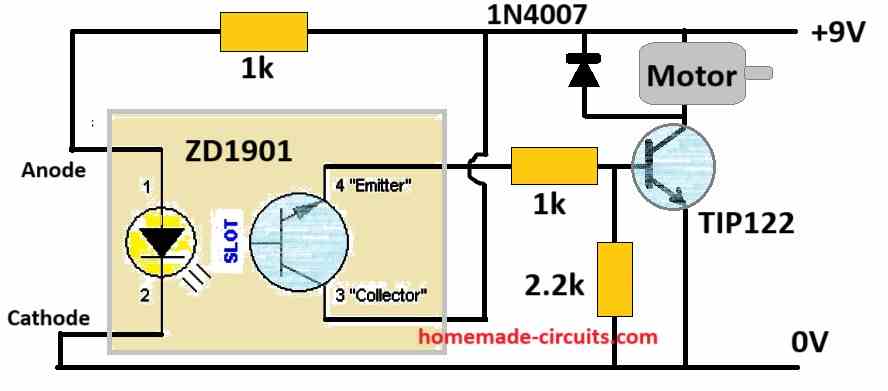
" rel="ugc">
When the LED light is unobstructed, the motor is ON. When the LED light is obstructed the Motor is OFF.
Thank you very much. Works well!
Now I have to circle back a bit. I need to change the voltage up to 12V which will be fine. This motor control needs to be triggered by a 5V “pulse” (a light on/off cycle). It needs to run independently of the trigger circuit until the opto is obstructed. This time I am guessing I need an NPN before the motor where the base is on the triggering circuit… but the base will need to stay high until the opto is obstructed. So it will need to connect with the opto collector? Is this right?
Thanks for your feedback, however I have some confusions.
In the following figure, the motor will start running as soon the +9V (or +12V) is applied to the circuit.
So what modifications do you want to have in the following design so that motor can be triggered by an external 5V “pulse” (a light on/off cycle), and it runs independently of the trigger circuit until the opto is obstructed.
" rel="ugc">
The circuit you suggested is good. So I guess the concept I am chasing is for this circuit to always be open unless it is triggered by a 5V light getting a pulse so it flashes. This flash then closes the motor circuit which remains closed until the opto is interrupted and it switches off the motor AND opens the motor circuit again. So power is always available to the motor circuit. But the motor is effectively switched on by the flash going off and switched off by the opto being interrupted.
Hope this helps
So where do we connect the opto interrupter LED in the previous circuit? Do we connect it with the 5v pulse?
I think that circuit from the motor input to the TIP output is good. Between the +9V and the motor needs to be open until the 5V flash pulse so I am guessing an NPN with the base going high from the 5V pulse. But it will also need to stay high until the opto is interrupted. So this “motor circuit” is closed by the 5V pulse and opened by the opto.
Ok, so I think you can try the following circuit: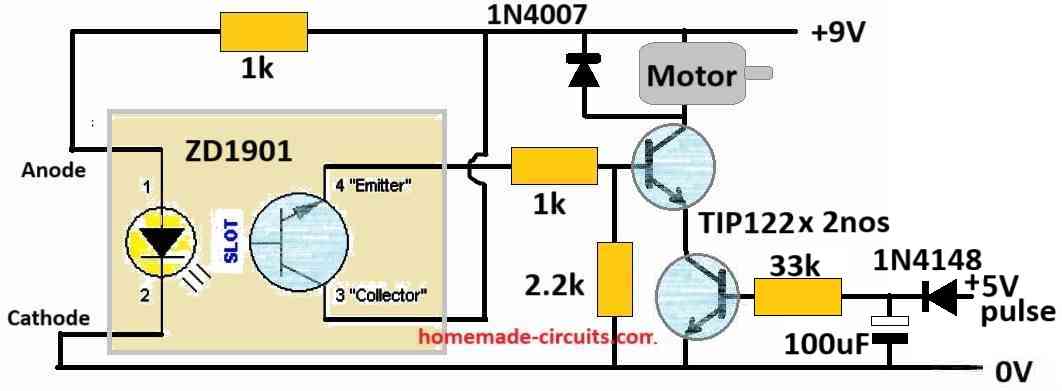
" rel="ugc">
Nice. Thanks for this… basically there. I noticed the control is not necessarily based on the opto though. I increased the capacitor to 470uF which gives me almost 3 rotations of the motor which is excellent. I also found that the pulse does not restart the motor as the cam on the motor remains over the LED opto. I have fixed this by connecting the motor directly to the incoming pulse which just moves the cam enough to clear the opto slot and then the motor circuit is closed and it runs until the cam comes around again. So this is exactly what I was after. Thanks for your assistance with this. Much appreciated.
Thanks for updating the results. Glad it worked. All the best to you!
Apologies but I spoke too soon. All good with what I have now it’s working. The other issue is that the whole circuit needs to ignore the input pulse from the flash for at least 30 seconds after the opto is interrupted. So I was thinking this could be done using some arrangement with the 4017IC you had mentioned in an earlier message. Or is there a simpler option?
Thanks
No problem, it can be designed using the IC 4017 and a small 30 second, however this idea may work consistently only if the IC 4017 circuit is allowed to reset after the 30 second period.
One more thing, If the input voltage was changed to 12V, should any of the components be changed for the higher voltage? The motor is rated 9-12V.
Nothing needs to be changed in the previous circuit for a 12V supply, all the parts can remain as is.
Thanks. 12V is much better. After reviewing what is going on electronically and mechanically, what would be the best way to open the circuit at the pulse while the opto is unobstructed? would it be feasible to use a PNP transistor across the pulse input and 33K resistor. Would the base be connected to the TIP emitter?
But the circuit or the motor is supposed to close (switch ON) when the input pulse arrives, right?
By “open” do you mean turn OFF?
I am not able to understand the new working.
Please elaborate a little.
Yes, a PNP can be used a switch to toggle the input pulse, between the input pulse source and the 33k. Emitter towards the (+) pulse source.
Switch ON scenario is correct. Yes I mean the circuit is open so its OFF. Now looking at it in its operating environment, I need the motor circuit to “ignore” all pulses UNTIL it is switched OFF when the opto is interrupted. When I am testing it I can send a pulse as many times as I like and the motor keeps turning. I am having difficulty deciding how to ignore the pulses – either using the 4017IC to set a “lock-out” period or to do something which ignores the pulses as mentioned above.
Yes, the 4017 can be used to ignore the pulses. This can be set depending on the number of rotations for which the pulses need to be ignored.
So using two 4017 I can keep the base on the PNP transistor high for say 30s? Then reset the first 4017 at pin 15 from pin 7 on the 2nd 4017, correct? The timer circuit would also be closed (ON) with the first pulse and then it should ignore additional pulses for 30 seconds. Does that seem correct? Thanks
Yes, that’s absolutely correct. However, holding the 30s period will depend on how many pulses are sent within these 30s.
If the number of pulses are more then 18 then two 4017 ICs might not work, because you can get only as many as 18 outputs from two cascaded 4017 ICs.
Hi sir..I want to build a personal website filled with my personal electronics design interests and wish to build my skills with a dedicated storage space organized neatly.So please help me on how to create website like yours.
Hi Girish,
You can create and manage a website cheaply on a WordPress platform.
Learning WordPress is a comprehensive process and can take many months to master. However as far the initial setup is concerned, you don’t have to worry at all, since it will be done by your hosting provider. You can also take their help to further learn regarding how to optimize your WordPress site. Go for hosting provider who offer the best SSD storage with litespeed cache, compare the plans and select which you find the most economical.
lm386 is running very hot very hot to touch is this normal?
It is not normal, how much supply voltage did you use? Try with 5V first then try 9V.
Hi, I’m Albrecht.
I’m looking around for a low noise amplifier for very tiny amounts of charge. For low low noise reasons I consider to use an Agilent ATF-55143, Although this device is made for rather high frequency applications in my case the required frequency band is more like “DC”, i.e. 10kHz up to 3MHz. Are there somewhere advices how to bias in an optimal way the pHEMT in order to get the maximum S/B ratio?
Hello Albrecht,
Did you check its datasheet, I can see some related information being available at the bottom section of the datasheet.
https://www.farnell.com/datasheets/33952.pdf
HI
is there a component tester for intergrated ccts eg LM386 ?
Hi, the easiest way to test the IC is by building its basic configuration as shown below: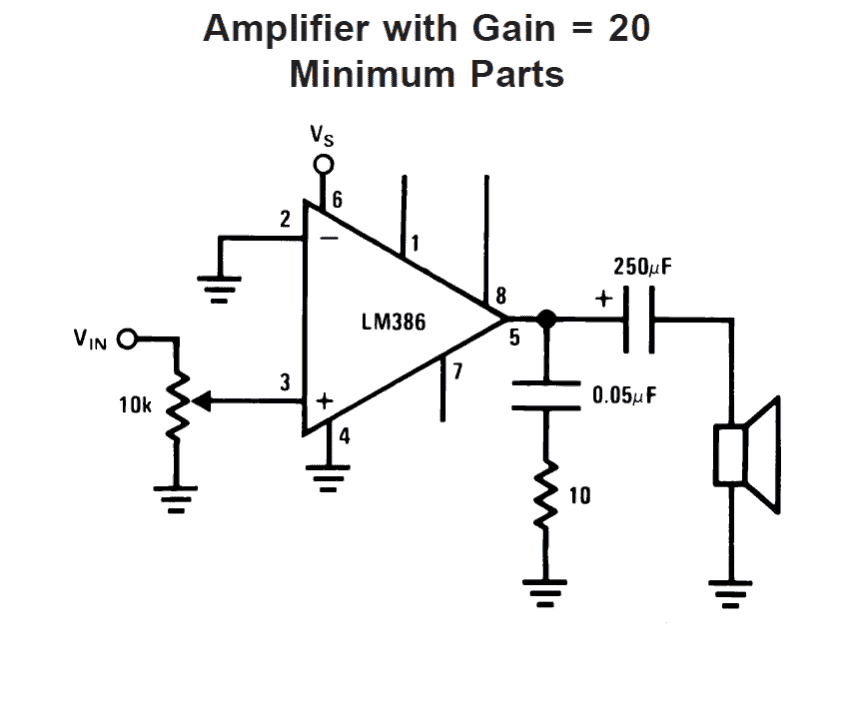
" rel="ugc">
The pot is not required. Simply touching the pin#3 directly should cause the speaker to generate a loud buzzing sound, indicating a good IC.
I have a relatively high impedance voltage source that puts out +/- 200 mV depending on the pH of the solution it is exposed to. I would like to have a simple op-amp based circuit that would apply a opposing voltage to this device such that net zero current flows. I would be monitoring the opposing voltage. The overall impedance is of the order of 1 MOhm, so the short circuit current otherwise will be in nanoamps. So the need is for a zero current, constant current circuit…
Your thoughts are most appreciated…
As per my understanding, you want another 200mV DC source through an opamp that could be connected with your existing 200mV?
Please let me know if I understood it correctly.
Yes basically so. It will end up applying exactly negative of the voltage the exiting probe is generating, in the extreme +/- 450 mV.
Sorry, I am still having problems understanding the configuration.
Do you want to sink the existing 200mV source to GROUND?
This can be done by shunting the source to ground with a jumper, what is the role of the op amp supposed to be here?
Hi boss, thanks for the circuit diagram. But I have some issues. 1, I don’t understand what kind of dieyot is D3 and I can find 48volt relay, is there any resistor I can use to convert it to either 12or 24volt relay. 2, which of the virable resistors is responsible for setting the low voltage level. Like if I want the relay to come or at either 50,40 or 30 percent. Thanks for all your response.
Hi Jolly, which circuit are you referring to? Please reply under the same comment so that I can refer to the circuit diagram.
The 48volts monitoring relay circuit
Sorry I cant find the original post where you posted you previous question.
Hi, I can’t find it either. But I received a circuit diagram for the 48volts battery monitoring relay. The idea was that the system is a 48volts system. The device was to monitor the 48volts when the voltage get low to like 30 or 40 percent a relay on the monitoring device should switch on and when the battery goes to full level the relay should switch off. I got a circuit diagram from you today about it but there are some things I’ll want to to look into on the drawing.
Your initial question was posted under the following article. Please ask it under the same thread, I will try to help:
https://www.homemade-circuits.com/3-step-dc-voltage-level-monitor/
Pls can I see some of this components to buy in Nigeria
I find this site very educational, thank you Swagatam and everyone.
I have the a need for the following device. Would be grateful for your help in building it.
—————————-
Light trap for Insects : the device turns on LED light automatically at dusk for 2-4 hours and attracts harmful insects in a crop field.
Device should not overcharge the battery, nor allow it to be depleted below a certain level to extend battery life.
Device should have a switch to manually turn the lights on and off.
The device should use low cost components since I need to deploy many of these devices.
The device should be essentially weather proof as it will be deployed in open field.
Thank you in advance for your help!
Thank you OP,
I will try to design the circuit soon, and let you know once it is done.
Thank you Swagatam, truly appreciate your help in this regard.
Thank you OP, I have published the article, you can find it under the following link:
https://www.homemade-circuits.com/insect-light-trap-circuit-for-protecting-crops/
I have simple mosfet wire loop security device but there is an issue the thieves can can joint the loop before the protected gadget thus making the system normal and steal the protected gadget can you design a wire loop circuit such that it activates alarm on both cutting and jointing the loop
Please i will be very thankful
Hi Swasti,
If the intruder already knows the location of the trip wire and manually fixes it then there’s nothing we can do. The trip wire or the loop wire is supposed to be hidden from the intruder, if it is visible or known to the intruder then it is impossible for it to work effectively. In that case better to install a simple PIR based alarm circuit or a motion detector alarm circuit.
Thank you sir
Yes sir i have considered pir based alarm and think but In my case there in the protected area sometimes animals like dogs and cats are walking so it is possible that most of the times my PIR based alarm will give false alarms therefore it is failed
Kindly if you have another idea or circuit then please guide me i need your support please
Hi Swasti,
Yes, PIR sensor or any other motion sensor will detect animals also and give false alarm, which cannot be avoided.
I think a vibration sensor can be the best option in that case, which will detect strong vibrations if an attempt is made to remove the solar panels from their installations.
Let me know your thoughts on this.
Sir you are the expert if you consider it helpful then i will be waiting for the circuit diagram of vibration sensor please make i perfect diagram so that i make the device soon
I appreciate ?
Thank you Swasti,
According to me the first circuit from the following article will be most suitable for you:
https://www.homemade-circuits.com/simplest-sound-activated-relay-switch/
You can reduce the sensitivity of the MIC simply by increasing the value of R1 to 10k or 22k or 33k.
You can enclose the whole circuit in a plastic box and clamp it with your solar panels. If anybody tries to remove the solar panels or tries to tamper with the circuit box, the relay will be instantly activated causing the alarm to sound.
If you want more information about the circuit details or the construction you can comment under the above linked article post, I will try to sort it out for you.
The LEDs are 3.4 v, 20 mA white, it is only 1 square of 44 x 60 cm. Thank you.
OK, I have designed the circuit, you can find the post in the following link:
https://www.homemade-circuits.com/automatic-night-activated-wireless-light-circuit-for-paintings/
Good afternoon, regarding the LEDs, I did a test with 6 LEDs but I need more light, so I ask your suggestion which would be the ideal one and regarding the battery, as you told me, it can be either solar or AC rechargeable.
I thank you for your attention and support of this important project for me. Thank you.
It will be difficult for me to know how much light you need for the painting. It will depend on the size of the painting, and the number of paintings.
If 6 LEDs are not enough, you can try 10 LEDs.
I will also need to know the specifications of the LEDs you are using (Voltage and current rating)
Disculpe, no encuentro mi comentario donde lo podre encontrar y verificar el favor que le pedí.
The comment might have disappeared for you maybe due to the automatic clearing of the site cache, but no worries, I have received your comment and will try to design it soon.
I’m Chibueze Nwakpuda from Nigeria, a regular follower of your blog. Please sir, I am experiencing difficulty in building electric stove using plaster of Paris (poo) as my element base. The pop cracks when heated. Kindly advise me on the substance I can place my heating spring coil element on that cannot crack.
Thank you.
Hi Chibueze, Sorry, I have no idea how the Pop cracking problem can be solved, it is beyond the scope of my expertise.
Good morning, I’m Carlos Velazquez. I hope you are in good health.
I’m trying to make a circuit that illuminates a painting at night for 14 hours. Starting at 6:00 p.m. and turning off at 8:00 hrs. The lighting is with LED, it must be activated with LDR when capturing the darkness outside and sending a signal with RF 433mhz and turned off when capturing the light by sending a signal to the receiver.
The transmitter must be outside the house powered by a solar cell that recharges a battery that does not consume much current and inside the receiver with a rechargeable battery, this process is daily.
For your attention, I thank you for your time and support.
Good Morning Carlos,
I will design the circuit and post it as a new article. Once it is done I will let you know.
Hi, how is LED lamp powered? Is it through a chargeable battery or from an AC outlet indoors. If AC outlet is available indoors then the receiver battery can be also charged through this AC source.
Yes, it is a rechargeable battery that is inside the house, could you suggest which battery to use? Thank you for your time
The battery voltage and Ah specifications will depend on the LED specifications. If you tell me the LED specifications, I can figure out the battery specifications.
How would you charge this battery, is it through the home AC outlet or through a solar panel?
Thank you very much!
I would like to know the values of R 45 and R 49 in Microtek VO 3.32 UPS board. In one circuit diagram it is 100K ohm both. Installed resistors in my board are 47 ohm each.Thank you.
Sorry, I do not have sufficient information regarding your question at this moment.
please let me join and get your projects